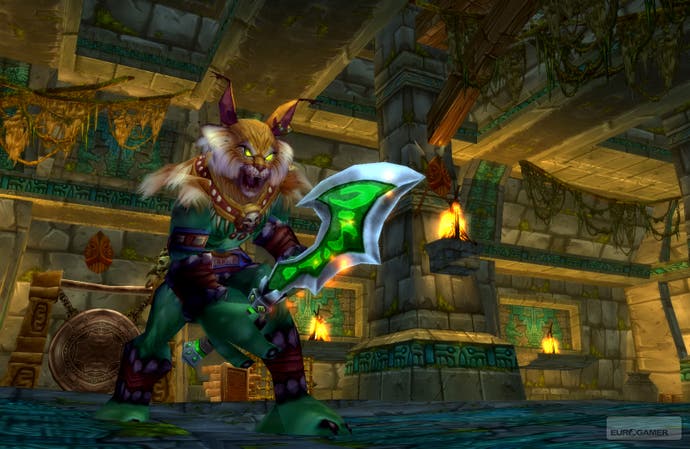World of Warcraft review
We're going to need a bigger Internet.
Unlike most other games, MMOs change over time. Audiences grow or shrink, features are changed, interfaces are overhauled, game balance is adjusted, new content and play styles are added, communities thrive or die. A review of an MMO can't be set in stone. So, on Eurogamer's new MMO channel, we'll be regularly re-reviewing the games to let you know the current state of play, and to help you decide whether it's time to jump in - or time to leave. Here's the first of these, about the biggest game: World of Warcraft.
Talk about the elephant in the room. It's impossible to discuss MMOs at the moment without talking about World of Warcraft. It dominates almost every conversation, and lurks, a leviathan-sized subtext, under the surface of all the others. Its unstoppable and truly global success - that imposing, 10-million-subscription bulk - acts as both carrot and stick. WOW lures rivals into MMOs with the promise of riches beyond their wildest dreams, before the seemingly insurmountable challenge of taking it on drives them away with their tails between their legs.
In the circumstances, it's easy to be cynical, or even resentful. It's easy to characterise Blizzard as calculating and exploitative pushers and slave-masters. It's easy to gripe about the game's grind, its cheerfully cheesy fantasy schlock, its lack of high-concept innovations, its broad and sometimes basic populism.
None of that holds water. World of Warcraft is the biggest because it's the best - by far, on both counts. And although sceptics, lapsed addicts and rival developers won't want to hear it, it just keeps getting better.
WOW might have made Blizzard stupendously rich and powerful, but it hasn't made it complacent. Its maintenance of the game goes far beyond tinkering under the hood and bolting on new features. Its drive to improve every aspect of the game experience is tireless.

In November last year, Blizzard rolled out an update called The Gods of Zul'Aman, known to some as Patch 2.3. The title refers to the addition of a new dungeon in which ten max-level players can take on the barbaric jungle trolls and their animal gods. But behind this tasty morsel of fresh adventure lay a sweeping revision to the game, the second such revision inside a year, just ten months after the release of first expansion The Burning Crusade.
Crucially, The Gods of Zul'Aman increased the speed at which characters level up between levels 20 and 60. Sound like a simple adjustment of some sliding scales? Well, it is, but its effect on the game is profound. Much of WOW's success is down to the heady rush of its first 20 levels, when power and skills and possibilities are channelled to the player in a constant, intoxicating stream. Round about the mid-20s, that stream used to dry up.
The game became an epic, heroic slog, with thousands of in-game miles to travel between disparate, sparsely populated questing grounds and disjointed storylines. Real confusion and lack of direction set in around the mid-30s, and the game didn't regain its focus until level 50 approached, and the original finishing line appeared on the horizon. It still worked - and provided you with plenty of amazing sights and adventures along the way - but you needed stamina and determination to make it through, and not everyone did.
That's all changed. For new players - and the high percentage of max-level players who like to start new characters to try out the game's enthralling selection of classes - that initial rush now never stops. If you make use of Blizzard's masterstroke innovation and keep your character "rested" - allowing you to level at twice the speed if you play less, provided you log out in an inn or capital city - you can make a new level every time you turn the game on and play for a couple of hours, right the way up to level 40.









